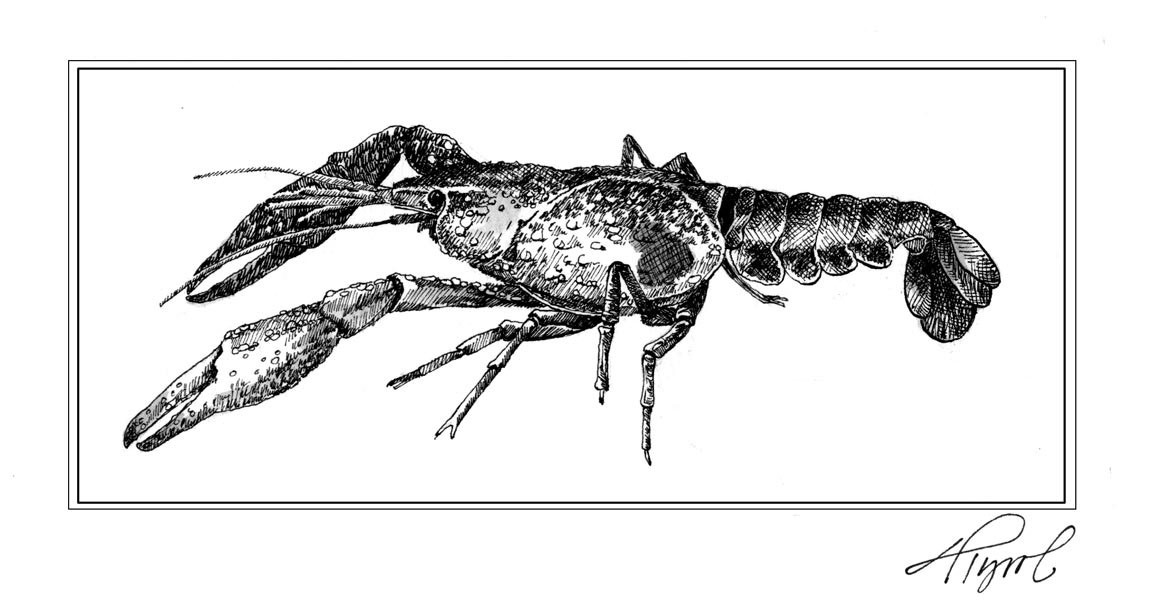
Invasive species don’t always arrive in North America in the bilge of a boat from Asia, in a shipment of wood from Europe, or from another distant shore. Some species, like the rusty crayfish, come from other states.
Normally, crayfish don’t move very far; some species are only found in a single watershed. So how did the rusty crayfish travel from its native range in the Ohio River Valley to northern New England?
“Primarily, they’re used as baitfish and then released into waterways,” says Leslie Matthews, an environmental scientist with the Vermont Department of Environmental Conservation’s Water Quality Division. “They’re also sold as aquarium species, then dumped when people empty their aquaria into waterways. Some get released after being used for classroom study. Commercial harvesters also move rusties around.”
The rusty crayfish, Orconectes rusticus, has hitchhiked as far as Ontario, New Mexico, and Maryland, and is now found in more than a dozen states, including every New England state but Rhode Island. Having first been recorded in Vermont in the 1970s, Matthews says that it is now “widely distributed in the Connecticut River and its tributaries and is dominant in the White River.” It is also found in Lake Morey in Fairlee and in Lake Carmi in northwestern Vermont.
“Only three species of crayfish are native to Vermont,” says Matthews, “but another five species have been introduced. In 2010, for the first time, the big water crayfish (Cambarus robustus) appeared in the White River. This crayfish species appears to have been introduced very recently, which suggests that people are still moving crayfish around and releasing them in the water. Therefore, the threat of the spread of rusty crayfish, as well as potential for other invasive introductions, continues to be high.”
Once a plant or animal is removed from its indigenous habitat and dropped into a new environment, it escapes the normal checks that keep it in balance with its surroundings. Most such species don’t survive in the new location, but those that do can create an ensuing “invasion” whose effects range from a slightly skewed food chain to the complete elimination of some native species.
At first glance, a rusty crayfish doesn’t look like an impending ecological disaster. Up to 4 inches long, it is somewhat bigger than our native species. The adult’s reddish-brown shell, or carapace, has a rust-colored spot on each side, says Matthews, “which looks like someone with red paint on their thumb and forefinger picked one up by the sides, like a lobster.” The black tip on each claw is another giveaway. These markings are easier to see when the animal is underwater.
Character and habit, as well as size, have earned this rapacious crustacean its notoriety. Rusty crayfish are aggressive and can eat four times the volume consumed by native species. They out-compete local crayfish for homes and food, including the bottom-dwelling insects and mollusks that are essential sources of energy for the aquatic food chain – from mayflies and stoneflies to leeches, snails, and waterfleas.
Rusties will even eat the eggs and young of native fish, including those of the bluegill and pumpkinseed. They can denude a river bottom of plants, destroying habitat and nursery grounds for fish and other animals. Their swift movements elude predaceous fish better than native species and churn up silt from the bottom.
If this weren’t enough, rusty crayfish hybridize with our native northern clearwater crayfish (Orconectes propinquus). One study in a Wisconsin lake found that, through competition and interbreeding, rusty crayfish supplanted and genetically assimilated the lake’s entire population of clearwater crayfish. Eventually, all of the crayfish looked just like rusties and only one quarter of the population had any northern clearwater crayfish genes remaining.
Because rusties mate in the autumn, and females store the sperm until they lay up to 500 or more eggs the following springtime, transporting a single fertile female into a new environment can easily start a new population. And once rusty crayfish become established, no form of management or control seems to keep them in check. Intensive trapping decreases numbers, but it has not been shown to eliminate the population.
It’s critical to know how to identify rusty crayfish and prevent them from spreading. Boaters must be sure that no crayfish or other invasive species are attached to a boat, motor, or trailer, and bilge water should be drained at the boat ramp before leaving a lake, river, or pond. Rather than releasing unused baitfish into the environment, anglers should freeze them and then compost the remains.
“If you trap crayfish,” says Matthews, “only use them where caught. Don’t dump your aquarium, and don’t buy crayfish from out of state, including the internet. It’s now illegal to import crayfish species into Vermont without a permit.”

